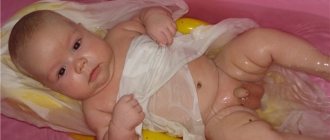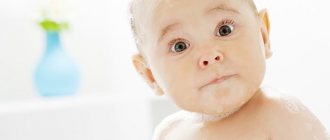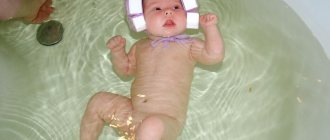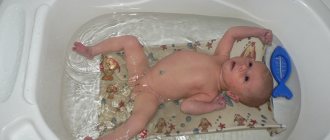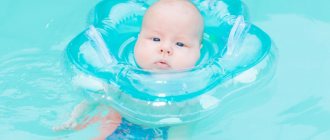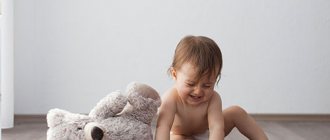Temperature
The room temperature should be 22-25 degrees. It should not be too hot and not too cold. What is more important is the absence of drafts. Close the windows and vents during this time.
The water temperature, as our grandmothers measured: by immersing the elbow in water: if it is normal for the elbow, then it is normal for the child. When your child is very young, you can use a thermometer.
As the child grows up, it becomes too lazy to use it, and the mother becomes more and more like an “elbow”.
The optimal temperature for bathing a one-year-old child and older is 32-33 degrees, this is exactly the temperature in children's pools. If your child is sitting in the bathtub and you are worried that the water has already cooled down, you should not add hot water if the child is comfortable in it.
Bathing in hot water does not have any benefit: it only dries the skin more, relaxes it and can have a laxative effect. Swimming, on the contrary, in cooler water strengthens and strengthens the immune system.
Just not harshly: you decided to harden the child and immersed him in an ice bath, under no circumstances! Very, very carefully, by lowering each bathing degree by degree.
How often should children of different ages be bathed?
After several moms started discussing how often they should bathe their babies on a Facebook page called Breastfeeding Mama Talk, we decided to share with you some expert advice on the matter.
According to the American Academy of Dermatology, parents who don't bathe their children every day are doing the right thing. Experts say that the frequency with which babies should take a bath depends on their type of activity and age.
Newborn babies and children under one year of age
It is not recommended to bathe newborn babies or children with limited mobility (who have not yet learned to walk) daily. Babies' skin is very sensitive, and daily bathing can cause dryness or irritation because the skin does not produce as much sebum as an older baby's skin does.
How often should newborns be bathed? It depends on you. A bath every 2-3 days or once a week may be enough, as long as you don’t forget about additional baths if necessary (for example, if there was an “incident” accompanied by an unpleasant odor, or the baby burped on himself, etc.).
Children aged 6-11 years
For this age group, showering daily is an acceptable option. However, this rule is not mandatory. And yet, how often is it recommended to take a bath for children aged 6 to 11 years?
- At least twice a week;
- When a child gets dirty (for example, playing in the mud);
- After swimming in the pool, in the sea or after playing in puddles;
- When he sweats and/or smells;
- As much as the dermatologist recommends if the child is registered due to the presence of skin diseases.
Children aged 12-18 years
All children are different, of course, for some, puberty begins earlier, this factor is the reason why this age interval is strictly indicative. If your child is over 12 years old, he should:
- Take a shower/bath daily;
- Wash your face twice a day to remove sebum;
- Shower every time after going to the pool, working out, or doing any other activity that results in excessive sweating.
How to Make Bathing More Enjoyable for Babies and Toddlers
Most parents, with the exception of a lucky few, know that taking a bath is a real challenge for both adults and babies. To make this process more enjoyable for your children, you should:
- Allow your baby to play with his favorite toy while bathing (suitable for playing in water, of course);
- Tell a story while you bathe him;
- Prepare a fluffy and pleasant robe for leaving the bathroom;
- Use pleasantly scented shampoos or soaps, as these can go a long way toward clearing the air (however, be careful with overly perfumed products, which can irritate babies' skin).
Source: baby.unica.ro
What to do if water gets into your mouth?
Sometimes this happens by accident during the game. Sometimes, if a child does not bathe in special devices, he can dive and take a sip of water accordingly. Sometimes kids do this on purpose.
My Danil really likes to play “pour over” with cups and sometimes he can specifically drink from this very cup. What to do in such cases?
Well, first of all, do not panic or yell at the child under any circumstances. He's just as scared as you are. If you scream, you will scare him even more, and what could be even worse - the child will be afraid of water and water procedures. Secondly, nothing terrible happened; a second dive will not lead to bad consequences.
If your child coughs or sneezes, which is the natural way to clear the airways, give him a good cough. If he’s just crying, you can take him out and hold him close to you, but he’s wet, so the child will understand that mom is always there and nothing bad happened.
If he goes back into the water, then you can continue swimming, but if he flatly refuses, then don’t force him, that means swimming is over for today.
When should you bathe your baby?
Pediatricians allow babies to be bathed immediately after discharge from the hospital, unless there are any other recommendations from the neonatologist. Even if the umbilical wound has not yet healed sufficiently, there are no contraindications for water procedures.
- Using a solution of potassium permanganate in bathing water is not recommended, since it can lead to overdrying of the baby’s delicate skin, and there is also a risk of causing a burn to the baby’s skin and mucous membranes due to undissolved crystals.
- Caution should be exercised when bathing a child in herbal decoction due to the risk of an allergic reaction to essential oils of plants.
- You can use shampoos and foams, the main thing is that they must be marked from birth (0+). It is recommended to use baby shampoos and foams no more than once a week.
Another aspect is time. We start with 3 minutes, gradually increasing to 20 minutes. If the baby is healthy, then up to 6 months you can bathe every day. After six months every other day. It is best if this happens in the evening.
The actual bathing
Just a reminder: the door to the bathroom is open.
It’s probably not worth sitting on a chair at first. When you get the hang of it, please.
So, we lower the baby into the water, the whole thing, so that only his face peeks out of the water. You can hold the child only by the head - the little finger under the neck, and the remaining fingers under the back of the head. The more your head is immersed, the better, and it's okay if water gets into your eyes, as long as your nose and mouth are on the surface. You can immediately notice the following: the body, which you are not holding at all, does not sink to the bottom, but, on the contrary, floats up. In this case, the chest and stomach, as a rule, stick out of the water. Therefore, with the second hand it is necessary to regulate the immersion of the torso so that both the chest and abdomen are completely under water. Please note that there is no danger of water getting into your ears.
! (We will remove excess water after bathing, and regular contact with water is not dangerous for the ears, if, of course, the beginning of contact and the habit of it occur during the newborn period. In addition, you need to know that earwax is constantly produced in the ear canal , whose role is to clean the ear from dust and dirt. By moisturizing the wax, we prevent its excessive accumulation and maintain proper cleanliness).
Once your baby is in a large bathtub, you will immediately understand the fundamental difference between this bathing option and soaking in a baby bath. You will see how easy it is for your child to move without any risk of hitting the walls of the bathtub.
Carefully observe the child’s behavior - if he is not active, lies quietly, yawns, then this water is warm for him, and therefore bad. Supporting the head, guide the baby in the water from one edge of the bath to the other. There is no point in especially experimenting for the first time - all participants in the bathing process still have to get used to and adapt, but it is much more difficult for parents to do this than for a child. In principle, three poses are quite sufficient for a home bath - one is described above, the other consists of swimming on the stomach (the child is turned over, his chin is between the thumb and forefinger spread apart), and the third is sitting.
It turns out that a child can sit in a large bathtub already in the newborn period! Further actions of parents do not require any special knowledge - only common sense. After all, it is obvious that after 15 minutes the temperature of the water in the bathroom will drop by one or two degrees, and this temperature will be already familiar to the child the next time he bathes. If you are afraid to quickly reduce the temperature, do this: start with 34 ° C and after two or three days reduce the starting water temperature by 1 ° C. We must ensure that the baby is active in the bath. What you succeed depends not only on you, but also to a large extent on the child. Each baby has unique features of body temperature regulation, and it is simply impossible to predict the minimum water temperature: one smiles at 23 °C, another screams at 30 °C.
The time and temperature guidelines are as follows:
- at the beginning of swimming - 34 ° C, 15 minutes;
- by one month of age - 30-32 °C, 20-25 minutes;
- at two months - 28-30 ° C, 30 minutes.
I emphasize - these are guidelines
. If a baby swims calmly at 24 °C at two months, it’s very good and not at all scary. But that doesn't mean he's that special. The fact of the matter is that anyone can do it! This child was just lucky with his parents. The latter are devoid of prejudices, and their level of common sense is above average. Everyone is interested in lengthening the bathing time and reducing the water temperature as much as possible. The more tired the child is, the more peaceful the night is guaranteed for his parents.
Since we are talking about the end of bathing, it should be noted: it is necessary to strive in every possible way to ensure that the duration of the procedure is at least 15 minutes. It is quite possible that the baby will be capricious, and you will not be able to determine what he wants. Try it, experiment. Change the temperature of the water and the position of the child in the water, move him more actively in the bath, maybe he is hungry and you need to change the bathing time next time (bathe not an hour before meals, but an hour after meals).
Let us note that if a child is “supposed” to bathe for 20 minutes, and he continues to behave decently - does not cry, twitches, etc. - then there is no need to rush. But as soon as one of the participants in the process is very tired, we end it.
Regarding a child's screaming in the bath, I will nevertheless allow myself two practical pieces of advice.
- The situation with water temperature often develops in such a way that a specific temperature - for example 28 ° C - is tolerated by the child well and with pleasure. But immediately after immersion in water, a sharp temperature contrast causes negative emotions and you have to calm down for about five minutes. You can do the following: prepare a bath with an acceptable temperature for the child, say, 32 ° C, and after a safe and calm immersion, speed up the rate of cooling of the water
. For example, make sure that a thin stream of cold water constantly runs into the bathtub. This technique can also be used simply as a component of hardening procedures - to activate cold effects. - For no apparent reason, a child systematically
screams in the bathtub. He didn’t scream before the bath, but he screams in the bath! Why? There is no clear answer. Parents' actions should be aimed at finding optimal conditions for a particular child that accompany the bathing process. Options:
- change the time of day
. For example, bathe not late in the evening, but early in the evening, or in the morning, or during the day; - change the time in relation to food
. For example, bathe not an hour before meals, but an hour after meals; - change the water temperature
- as a rule, we are talking about making the water warmer; - try to bathe with the mother
- that is, the previously washed mother is immersed in the bath, after which the baby is added there...
